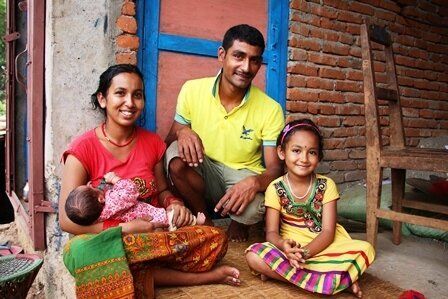
Baby Suman is one of thousands of children born into post-earthquake Nepal. His parents are proud and hopeful. But what does his future hold? Photo/World Vision
One year ago I rushed to Kathmandu after a 7.8 magnitude quake rocked Nepal. It was chaos everywhere, as thousands of families faced a real-life nightmare of collapsing buildings, buried loves ones, and the horrifying loss of all that's safe and familiar. I remember holding newborns in a clinic just days after the quake, wondering what life lay ahead. What barriers would babies born into such a fragile environment face? Would they have a chance to grow up healthy and thrive?
It's been a challenging year for aid organizations in Nepal. We're working in a tough environment. We've dealt with fuel shortages, huge landslides, monsoons, and frustrating road blocks. Despite these hurdles, we've managed to make great strides in meeting immediate needs. Within 24 hours of the earthquake hitting Nepal, World Vision was delivering food, tarps, blankets and water purification tablets. Over the past year, we've provided thousands of families with shelter and access to clean water, and repaired and equipped health posts and schools.
Work far from over
But our work in Nepal is far from over. Recovery from an earthquake of this scale can take 10 to 15 years. As in most earthquakes of this scale, shelter remains the critical need. Too many displaced families are still exposed to harsh living conditions and are vulnerable to extreme weather. While emergency shelter kits have been distributed in the hardest-hit areas, and winter kits and other essential supplied were provided to help families withstand the cold, construction of permanent housing needs to accelerate.
Understandably, in Nepal there's still a profound (and legitimate) fear of another earthquake striking. It's a sad reality that many Nepali mothers tell us they feel safer living in tents rather than another poorly constructed home. That's why we must do more than merely repair and restore. Houses, schools, health facilities, and infrastructure must be rebuilt stronger and better than before.
To do this, World Vision is training local masons, builders and homeowners on simple techniques for building sturdier structures. It's an approach that will not only make families safer, but will provide new skills to help people be active in their own recovery.
Building up people
Building up people, particularly women and children, is equally important during the recovery phase. Thousands of Nepali families are still fighting their way through immense shock and grief - not to mention steep financial loss. With their homes and livelihoods destroyed, their situations are dire. It's critical for survivors, especially the most vulnerable, to gain new skills and knowledge of their rights.
In Nepal, we're offering entrepreneurial training and cash grants to help women and youth start up small businesses. We're promoting gender equality and social inclusion throughout our programs, which is vital to create stronger communities. Such an intense focus on empowerment leads to resilience, and results in families and communities becoming more equipped to deal with future shocks and disasters.
As a humanitarian, I'm encouraged that the families we are working with are resilient, determined, and willing partners in the process of rebuilding. Recently I learned of one family that donated a piece of land for the construction of a new health facility. We are seeing many examples like this, as families increasingly take ownership of their own recovery, for their own children's future.
Continuing our work
We must continue to stand alongside Nepal. In the immediate aftermath of the earthquake, Canadians were generous with donations that helped deliver life-saving aid and a chance at survival for thousands. This Canadian aid didn't end even when the news headlines did.
At these one-year-later moments, headlines inevitably reappear. There's no denying the challenges are real, and there's no doubt we can expect more. But let's not allow ourselves to become cynical. As donors, we need to be patient, flexible and think long-term. To do the most good in the long run, Canadian support needs to allow for the ups and downs of an unpredictable recovery.
Hope can grow, even in fields of rubble.
Follow HuffPost Canada Blogs on Facebook